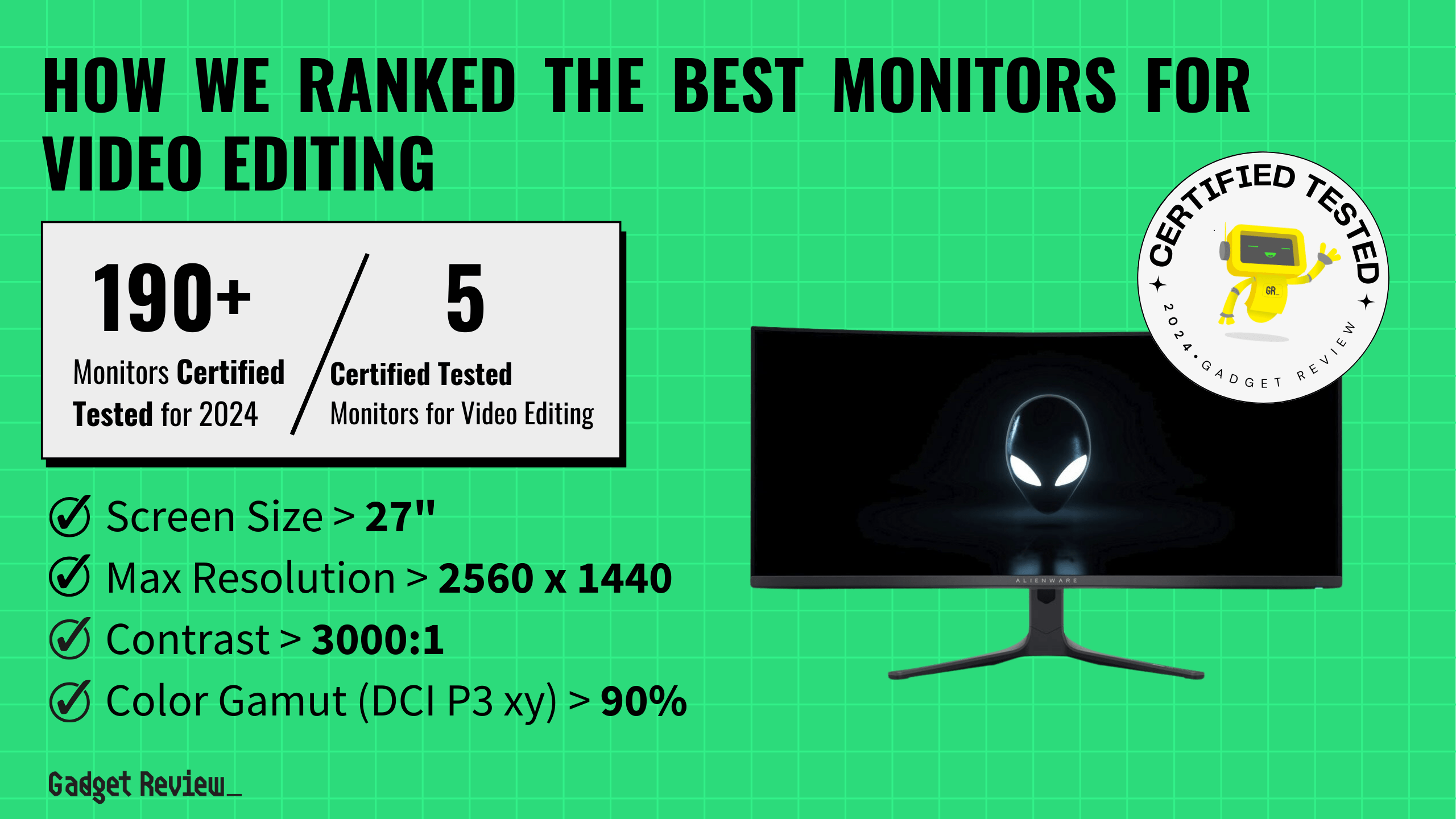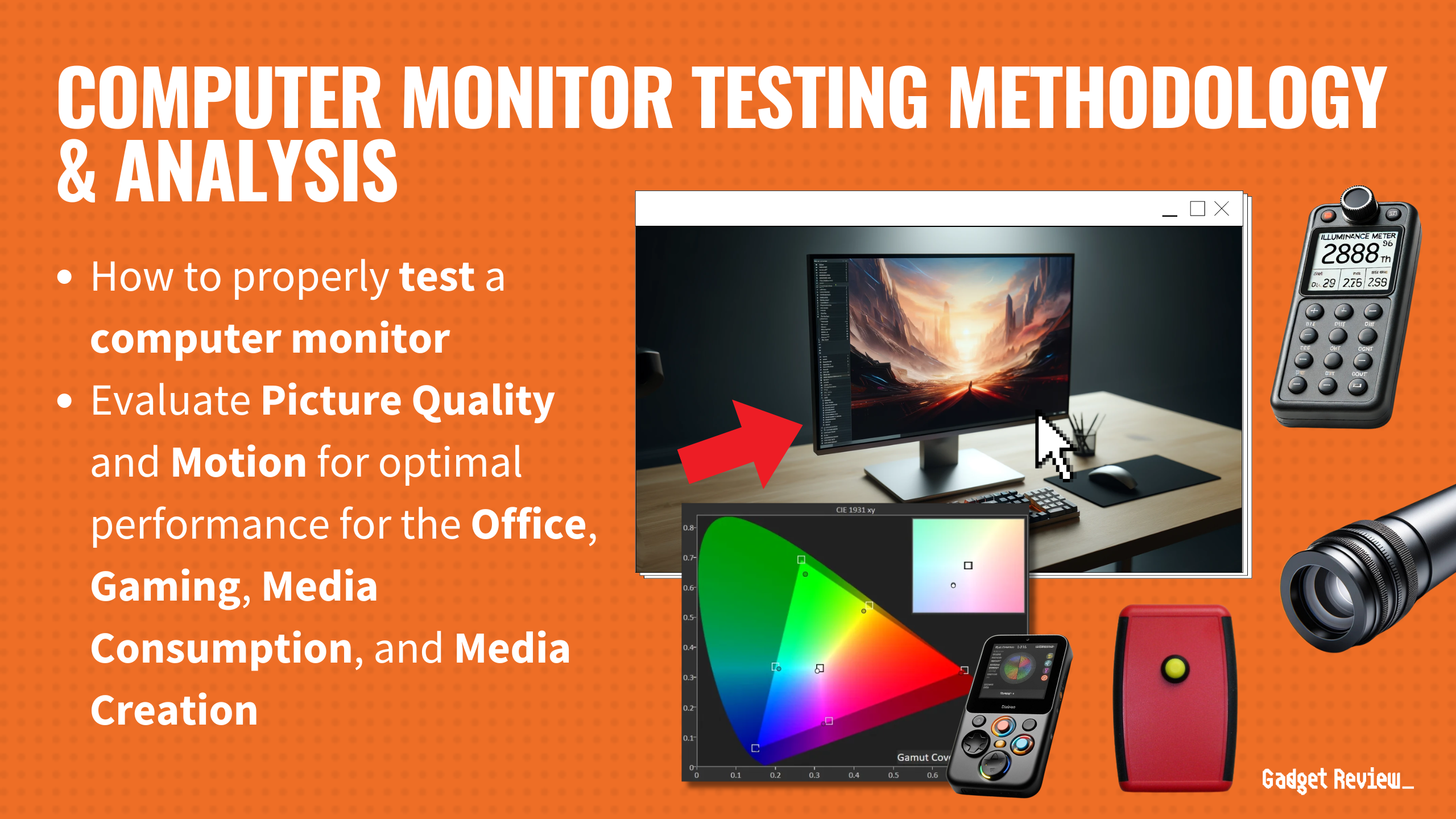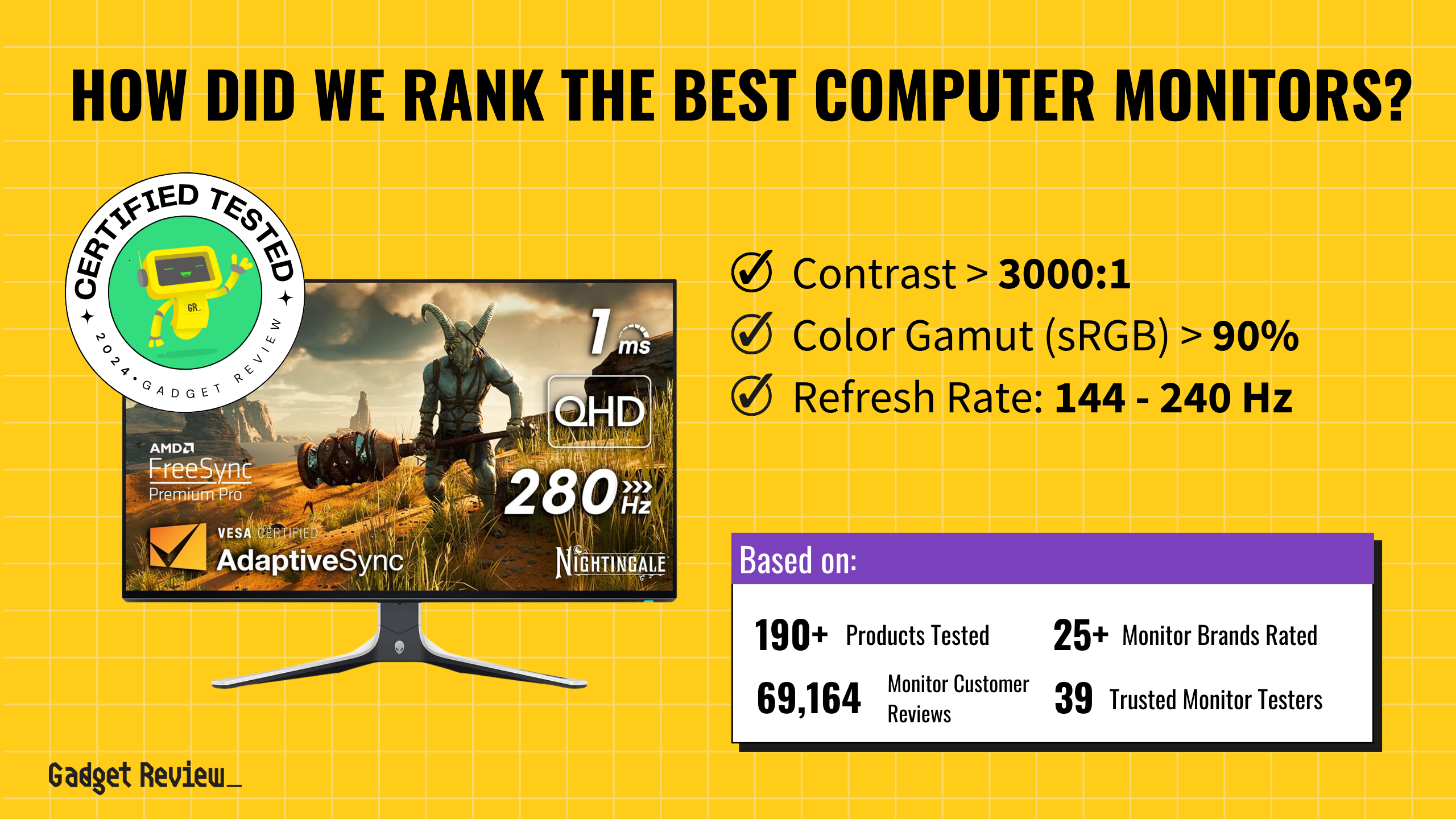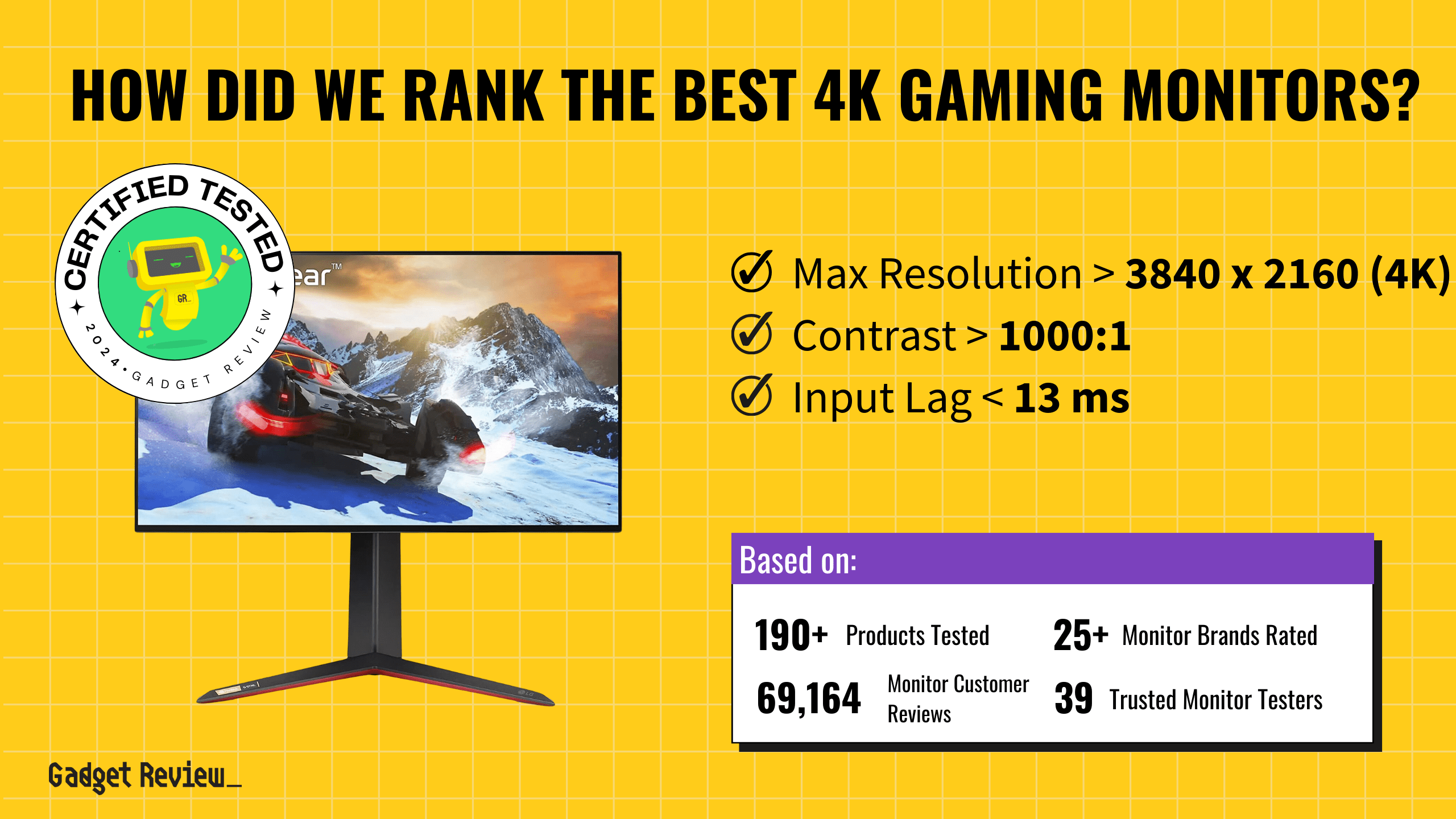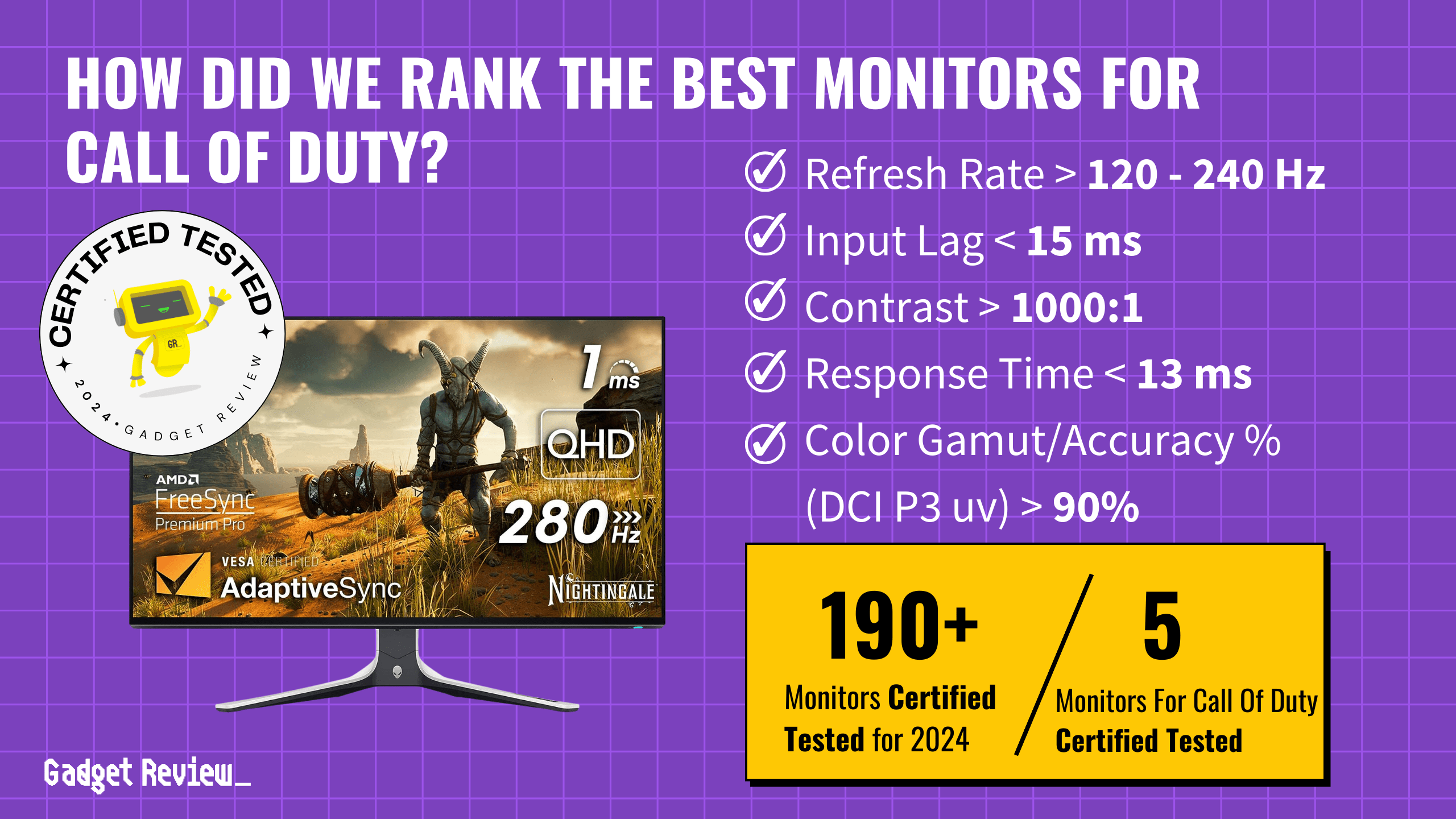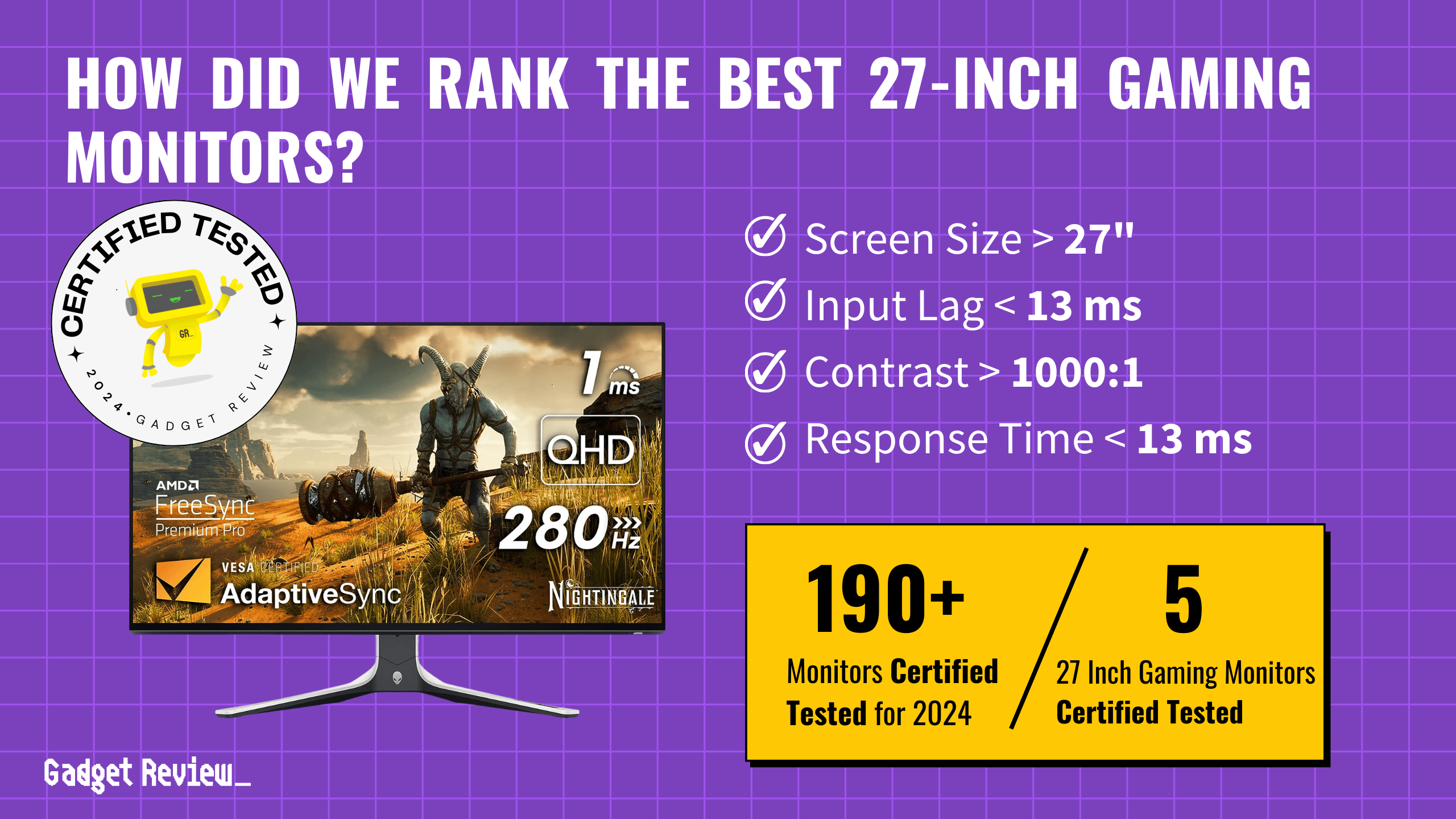For video editing, you need a monitor with excellent contrast ratios, full color gamut coverage, and a high resolution of at least 1440p to ensure accurate color representation and ample screen real estate. Features like blue-light filters, flicker-free displays, and ergonomic adjustments are beneficial for long editing sessions.
We analyzed 196 monitors and filtered out 71% of untrustworthy expert reviews, leaving us with 321,839 verified reviews. Our unique approach certified 5 monitors as top choices for video editing based on their performance, verified testing, and filtered reviews. These monitors excelled in key areas like color accuracy, brightness, and contrast ratios. While this guide primarily focuses on video editing, other guides highlight the top gaming monitors, delivering high refresh rates and low latency or the best overall computer monitors for any use case. For those seeking value, our top budget monitor guide has options that offer solid performance without breaking the bank.
Below is our list of the 5 best monitors for video editing.
How Did We Rank the Best Monitors for Video Editing?
We’ve crafted the ultimate guide to video editing monitors by analyzing more than 200 websites. By evaluating various testing methods and examining customer reviews, we pinpointed the key features video editors need. Our in-depth analysis identifies 2 required test results and 2 must-have specifications, ensuring you find the perfect monitor for impeccable color precision, clarity, and connectivity.
Our commitment to unbiased reviews is powered by our ‘True Score’ system, targeting low quality and fake reviews. When you shop through our links, you’re backing our mission. Dive deeper to see how.
?️ Minimum Specifications
- Must have a screen size of 27″.
- Must have a max resolution more than 2560×1440.
? Test Criteria
- Contrast Ratio: 3000:1 or higher (infinite), offering deep blacks and bright whites for an exceptional viewing experience.
- Color Accuracy: At least 90% of the DCI P3 color gamut, providing rich and vibrant colors.
Latest Updates
- 05/02/2024: Republished the list to include the best monitors for video editing based on our True Score system.
Top Monitors for Video Editing For 2024
Prices accurate at the time of publishing

Best Overall

Runner Up

Best Value

Best Budget

Best Mid-Range

Premium Pick
Dell Alienware AW3423DW
Best For Mac Mini
Ideal for video editors needing ultrawide, color-accurate displays, this product offers exceptional color gamut and contrast but struggles in bright light. Its fast response enhances editing and gaming, and its high cost reflects its OLED quality.
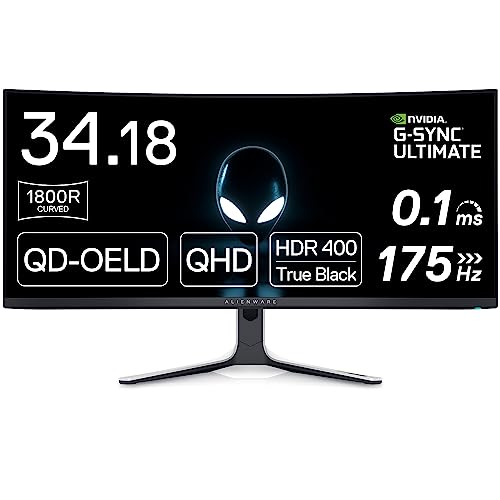
True Score
828514Experts
872kCustomers
Absolutely Fresh
 SAVE $200$1,099.99$899.99
SAVE $200$1,099.99$899.99Snapshot
Reasons to Buy
- Spectacular image quality
- Ultra-fast response time
- Low Input lag
- High native refresh rate
Reasons to Avoid
- Bright surroundings reduce black levels
- Not suited for gaming consoles
Specifications

Aspect Ratio 21:9 
Available Inputs 3.5mm, DisplayPort, HDMI, USB 
Bluelight Filter Yes 
Built-In Speakers No 
Built-In Webcam No 
Curved Screen Yes Display Type OLED 
Flicker Free Yes HDMI Inputs 1 HDR Format HDR10, HDR400 High Dynamic Range (HDR) Yes Max Resolution 3440 × 1440 
Panel Type n/a Refresh Rate 165 Hz 
Response Time 0.1 ms 
Rotating Screen No Screen size 34″ 
Sync Technology AMD FreeSync Premium Pro, G-Sync Ultimate All Specs
Test Results
Brightness (nits) 241 Contrast Ratio (as ratio, x:1) 0 Color Gamut/Accuracy % (DCI P3 xy) 100 Color Gamut/Accuracy % (DCI P3 uv) 0 Color Gamut % (Adobe RGB Coverage xy) 96 Color Gamut % (sRGB Coverage xy) 100 All Retailers
- $899.99$1,100Save $200
- $899.99
- $914.95
Our Verdict
The Dell Alienware AW3423DW is an ultrawide monitor that brings an exceptional color gamut coverage of 99.8% DCI P3 to the table, perfect for video editors who need high color accuracy for their work. The OLED display also offers exceptional blacks in dark scenes, providing the near-infinite contrast that the tech is known for (but in practice, the contrast ratio is lower because of how it interacts with brightness.) The large 34-inch screen is also ultrawide, providing a detailed canvas for video editing by giving you a clear view of the editing timeline and tools.
It suffers in the brightness department; at 241.39 nits, it’s good enough for your average office, but it’ll struggle if you have lots of natural light. On the upside, the monitor features a fast response time of 1.96 ms, reducing motion blur and making it easier to edit fast-paced videos. Its input lag of 20.5 ms is strange for a gaming-oriented brand like Alienware, but this input lag lowers dramatically when running it at its 165 Hz refresh rate and matching it with games running at a similar frame rate.
The monitor also features a blue light filter and flicker-free technology to help reduce eye strain during long editing sessions, enhancing its usability. Its 100% sRGB coverage also means that it works great for web browsing and graphics design.
While the curved screen may not appeal to everyone, it can enhance the editing experience if you like feeling “wrapped” in content. The AW3234DW is a great choice for anyone looking for a high-quality video editing monitor with a large, ultrawide screen, exceptional color accuracy, and OLED contrast, though it does come at a high price, as OLEDs usually do.

Best Overall

Runner Up

Best Value

Best Budget

Best Mid-Range

Premium Pick
Corsair Xeneon 27QHD240
Best For Business
For precision and speed in dynamic content, the Corsair Xeneon 27QHD240 delivers unparalleled performance, ideal for professional tasks and gaming.
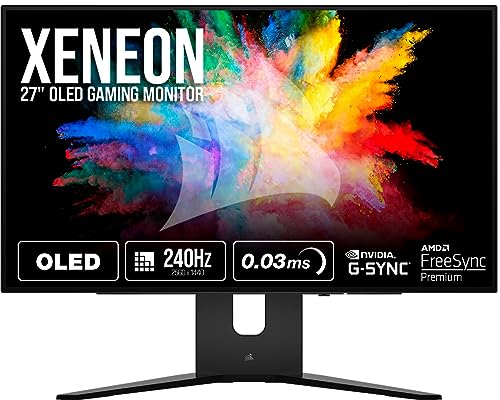
True Score
828310Experts
88334Customers
Absolutely Fresh
 SAVE $300$999.99$699.99
SAVE $300$999.99$699.99Snapshot
Reasons to Buy
- Excellent OLED Picture Quality
- Ultra-Fast Response Time
- Low Input Lag
- High Refresh Rate and VRR Support
Reasons to Avoid
- Lower Peak Brightness Levels
- Higher Input Lag with Different Refresh Rates
- Potential OLED Burn-In
Specifications

Available Inputs 3.5mm, DisplayPort, HDMI, USB 
Bluelight Filter Yes 
Built-In Speakers No 
Built-In Webcam No 
Curved Screen No Display Type OLED 
Flicker Free Yes HDMI Inputs 2 HDR Format HDR10 High Dynamic Range (HDR) Yes Max Resolution 2560 x 1440 
Panel Type OLED Refresh Rate 240 Hz 
Response Time 0.03 ms 
Rotating Screen Yes Screen size 27″ 
Sync Technology AMD FreeSync, G-Sync All Specs
Test Results
Brightness (nits) 318 Contrast Ratio (as ratio, x:1) 9,473 Color Gamut/Accuracy % (DCI P3 xy) 96 Color Gamut/Accuracy % (DCI P3 uv) 0 Color Gamut % (Adobe RGB Coverage xy) 90 Color Gamut % (sRGB Coverage xy) 107 All Retailers
- $699.99$1,000Save $300
- $699.99$1,000Save $300
- $699.99
Our Verdict
If you need a vertical monitor that excels in rendering dynamic content with crystal-clear precision, consider the Corsair Xeneon 27QHD240. Its unmatched 0.8 ms response time and 13.6 ms input lag ensure rapid, accurate visuals, perfect for high-speed tasks. With a 240 Hz refresh rate, it’s ideal for demanding professional environments and critical gaming moments where every millisecond counts.
The OLED panel of the Corsair Xeneon 27QHD240, boasting an infinite contrast ratio, brings depth to visuals with its deep blacks and vibrant colors, enriching the vertical viewing experience. Its 96.1% DCI P3 color gamut coverage excels in creative tasks like graphic design or video editing, ensuring precise color fidelity. Although for color-critical work, the Tempest GP27U offers greater coverage. Despite a brightness of 317.53 nits, it provides ample visibility across lighting conditions. Additionally, its minimal reflectivity of 1.8% reduces glare and maintains clear visibility, which is essential for vertical use in tasks such as reading and coding.
Despite its higher price point, the Corsair Xeneon 27QHD240’s features, such as its versatile rotating screen, justify the investment. This adaptability makes it easy to switch between orientations, accommodating a wide range of tasks from gaming to professional workflows. Its eye-care technologies, like blue light filtering and flicker-free display, provide a comfortable viewing experience and reduce eye strain during prolonged use.
The Corsair Xeneon 27QHD240 offers excellent value in terms of performance and features. Its low response time, high refresh rate, and rotating screen feature make it a great choice for those who require a vertical monitor for other tasks.

Best Overall

Runner Up

Best Value

Best Budget

Best Mid-Range

Premium Pick
Samsung Odyssey G85SB
Best For Samsung
It boasts supreme color gamut coverage and an ultrawide screen for extensive timeline views. OLED’s low brightness limits its use in well-lit areas. The high refresh rate and gaming-ready specs add versatility. It is premium priced for outstanding accuracy and contrast.
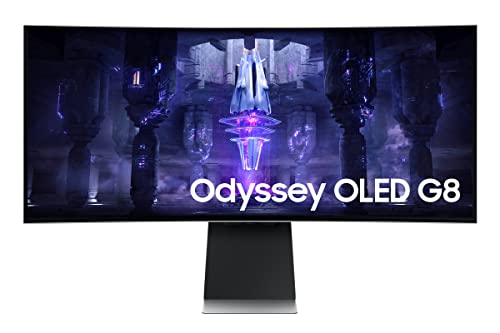
True Score
828210Experts
878kCustomers
Absolutely Fresh
 SAVE $400$1,199.99$799.99
SAVE $400$1,199.99$799.99Snapshot
Reasons to Buy
- Great image quality
- Fast response time
- Low input lag
- Outstanding refresh rate
Reasons to Avoid
- Low peak brightness
- Subpar ergonomics
Specifications

Aspect Ratio 21:9 
Available Inputs HDMI, USB 
Bluelight Filter Yes 
Built-In Speakers Yes 
Built-In Webcam No 
Curved Screen Yes Display Type OLED 
Flicker Free Yes HDMI Inputs 1 HDR Format HDR10, HDR10+, HDR10+ Gaming, HDR400 High Dynamic Range (HDR) Yes Max Resolution 3440 × 1440 
Panel Type n/a Refresh Rate 175 hz 
Response Time 0.1 ms 
Rotating Screen No Screen size 34″ 
Sync Technology AMD FreeSync Premium Pro All Specs
Test Results
Brightness (nits) 237 Contrast Ratio (as ratio, x:1) 0 Color Gamut/Accuracy % (DCI P3 xy) 110 Color Gamut/Accuracy % (DCI P3 uv) 0 Color Gamut % (Adobe RGB Coverage xy) 96 Color Gamut % (sRGB Coverage xy) 141 All Retailers
- $799.99$1,200Save $400
- $1,199.99
- $1,199.99
- $1,499.99
Our Verdict
If you need unmatched gamut coverage and accuracy for your video editing, the Samsung Odyssey G85SB features an outstanding gamut coverage of 109.6%. Its outstanding coverage of a wide range of colors commonly used with film makes editing much easier, and the 34-inch screen size and ultrawide aspect ratio give you plenty of real estate to stretch an editing timeline across.
Unfortunately, like most OLEDs, the monitor’s brightness suffers. At 237.45 nits, it’s good enough for most editing environments but will struggle in bright rooms. The monitor’s refresh rate of 175 Hz is excellent for video editing and will ensure smooth playback of high-frame-rate content. Additional features like a blue light filter, flicker-free technology, and built-in speakers make it a well-rounded choice for video editors. However, the lack of a rotating screen may limit its setup flexibility.
Like other OLED panels, the G85SB features a functionally infinite contrast ratio, with extremely deep blacks and bright whites that LED monitors can’t match. However, the display’s low brightness skews the contrast ratio lower than the specs suggest. OLEDs are also susceptible to burn-in, so it’s worth keeping that in mind before leaving static elements on your screen for long periods. If you need a brighter display that’s also larger and less expensive, the Gigabyte Aorus FO48U is both, but it’s also not an OLED, which means you lose contrast and color accuracy.
Regarding responsiveness, its input lag of 13.4 ms and response time of 3.5 ms makes it excellent for gaming in your downtime. It provides a snappy, blur-free image, and the fast response time reduces blur in fast-paced video content.
While conventionally expensive, the Samsung Odyssey G85SB offers an excellent, accurate editing and viewing experience. It may struggle with lower brightness because of its OLED panel, but it provides outstanding color accuracy and coverage, unbeatable contrast, and even great responsiveness when video editing is done and it’s time to relax with games or fast-paced multimedia.

Best Overall

Runner Up

Best Value

Best Budget

Best Mid-Range

Premium Pick
Gigabyte Aorus FV43U
Combines huge screen size with extreme brightness, making it perfect for brightly lit environments. Excellent color accuracy and contrast ratio enhance video editing. Very affordable for its size and performance, blending work and play effectively.
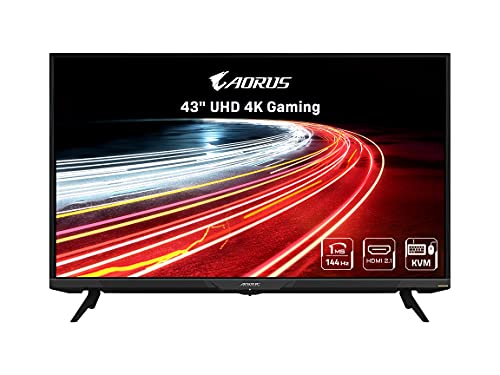
True Score
78784Experts
84637Customers
Mixed Reviews
 $749.99
$749.99Snapshot
Reasons to Buy
- Great contrast ratio
- High 144Hz refresh rate
- Sharp picture quality
- Low input lag
- High color accuracy
Reasons to Avoid
- Poor ergonomics
- Narrow viewing angles
- Bad local dimming feature
Specifications
Display Type VA HDMI Inputs 2 HDR Format Yes Max Resolution 3840 x 2160 (4k) 
Panel Type VA Refresh Rate 144 Hz 
Response Time 1 ms Screen size 43″ 
Sync Technology AMD FreeSync, G-Sync All Specs
Test Results
Brightness (nits) 904 Contrast Ratio (as ratio, x:1) 4,982 Color Gamut/Accuracy % (DCI P3 xy) 99 Color Gamut/Accuracy % (DCI P3 uv) 150 Color Gamut % (Adobe RGB Coverage xy) 98 Color Gamut % (sRGB Coverage xy) 99 All Retailers
- $749.99
- $749.99$1,528Save $778
- $749.99$800Save $50
Our Verdict
If you need to do your video editing in an office with a lot of ambient light, the Gigabyte Aorus FV43U’s brightness of 904.495 nits will conquer anything but direct sunlight on the display. The monitor is also huge, with a 43-inch ultrawide display that provides a lot of real estate to lay out windows or stretch a video timeline across.
The FV43U’s performance is further enhanced by its excellent contrast ratio of 4981.65:1, which delivers deep blacks and a wide dynamic range for your video content. Additionally, its nearly perfect DCI P3 color gamut coverage of 99.43% guarantees accurate color representation, which is crucial for professional video editing.
It’s worth noting that the FV43U’s response time of 3.93 ms and input lag of 21.7 (lower at higher refresh rates) ms are largely intended for gaming, but if you like a little work with your play, it’s a nice bonus.
Despite the immense size, the FV43U is surprisingly affordable (but still expensive), providing more monitors for your dollar than other displays on our list. Its unbeatable brightness and near-perfect color accuracy, combined with its more accessible price point, make it a compelling choice for video editors looking to maximize their screen size without skimping on color accuracy.

Best Overall

Runner Up

Best Value

Best Budget

Best Mid-Range

Premium Pick
Gigabyte Aorus FO48U OLED
This colossal 48-inch OLED offers deep contrast and accurate colors for professional editing. It has adequate indoor brightness and a high refresh rate for smooth playback. It is excellent for video editing and has significant gaming appeal.
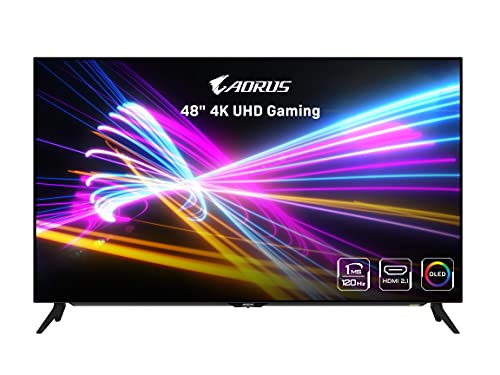
True Score
77784Experts
83203Customers
Mixed Reviews
 $1,243.25
$1,243.25Snapshot
Reasons to Buy
- Dual HDMI 2.1 ports for modern console gaming
- Wide viewing angles
- Great build quality
- Impressive reflection handling
- High refresh rate
Reasons to Avoid
- Poor HDR brightness levels
- No ergonomics
- No cable management
Specifications
Display Type OLED HDMI Inputs 2 HDR Format Yes Max Resolution 3840 x 2160 (4k) 
Panel Type OLED Refresh Rate 120 Hz 
Response Time 1 ms Screen size 48″ 
Sync Technology AMD FreeSync, G-Sync All Specs
Test Results
Brightness (nits) 282 Contrast Ratio (as ratio, x:1) 135k Color Gamut/Accuracy % (DCI P3 xy) 95 Color Gamut/Accuracy % (DCI P3 uv) 130 Color Gamut % (Adobe RGB Coverage xy) 87 Color Gamut % (sRGB Coverage xy) 100 All Retailers
- $1,243.25
Our Verdict
If you’re a professional video editor seeking the largest possible display for complex projects, the Gigabyte Aorus FO48U OLED is what you’ve been looking for. Its 48-inch screen size and 3840-pixel width provide ample space for detailed work without straining your eyes. The OLED panel boasts an exceptional contrast ratio of 135,000:1 that delivers superb detail in both dark and bright areas of the image, making it a standout choice for video editing, though, in practice, this contrast ratio may be smaller as it relies on brightness.
Despite being an OLED, the FO48U provides a decent brightness of 282.33 nits, adequate for most indoor settings, though still not good in bright offices. The color gamut coverage of 94.82% DCI P3 is extremely good and provides accurate color representation for professional work on the enormous canvas the monitor provides.
The 120 Hz refresh rate ensures smooth motion for high-frame-rate content, which is sufficient for video editing and provides a smoother viewing experience, reducing eye strain.
While it may be marketed towards gamers, Gigabyte’s Aorus FO48U OLED offers excellent value for video editing with its large screen, impressive contrast ratio, and decent brightness. If screen size matters most for your video editing and productivity, the performance the Aorus brings is hard to argue with.
Which Criteria Matters for Testing Best Monitors for Video Editing?
By focusing on these criteria (2 required), anyone can quickly and easily compare these computer monitors and how they’ll perform. This helps you make an informed decision and purchase the best monitor for video editing.
| CRITERIA | RANGE | REQUIRED | DEFINITION |
|---|---|---|---|
| Contrast Ratio | >3000:1 | Yes | The difference in brightness between the whites (lit sections) and blacks (dim or unlit sections) of a monitor panel. |
| Color Gamut (DCI P3 xy) | > 90% | Yes | How much of the DCI P3 xy color gamut is covered by the monitor, which helps indicate color accuracy for HDR content, which includes certain movies. |
Our Trusted Data Sources
We looked at 110+ computer monitor reviewers and found that 33 are trustworthy (60%+ Trust Rating). The three we have listed below are our most trusted for computer monitors.
- Samuel Breton – Rtings, MuckRack
- Chris Eberle – Tom’s Hardware, LinkedIn
- Tony Hoffman – PC Mag, MuckRack
Interested in a comprehensive analysis of our data sources? We’ve got you covered. Below, you’ll find a detailed list of every computer monitor review website we’ve identified, organized by their respective Trust Ratings from highest to lowest. But we didn’t stop there. We’ve meticulously reviewed each publication and verified the data by checking whether the authors have bio links to MuckRack or LinkedIn. We’re committed to not only checking the facts but ensuring their veracity.
Computer Monitor Test Data & Results
3. Contrast Ratio (as ratio, x:1) Test Results
Contrast Ratio
> 3000:1
Acceptable range of performance
Definition: How bright the monitor will get, usually under specific testing conditions, like 10% windows (which means 10% of the screen is a white box.)
Units of Measurement: Ratio
Tools to Measure: Luminance meter or photometer or colorimeter
Why It’s Important:
Contrast ratio is how dynamic images are given detail and dramatic effect, with very dark areas appearing truly dark, while bright areas are bright and pop.
Contrast ratio is responsible for making images appear “dynamic” and “dramatic.” By having a good contrast ratio, a monitor is able to recreate dramatic differences between light and dark spots in scenes, images and games accurately.
At a minimum, we recommend a contrast ratio of 3000:1, as this will do a good enough job at allow for detail in dark scenes and images. If contrast ratio gets too low, the picture quality suffers, and the monitor performs worse across the board, no matter the lighting condition. By getting a monitor with a sufficiently high contrast ratio, you can ensure the picture quality doesn’t suffer, and dramatic scenes with stark shifts in lighting, whether they be in games or videos, are created as accurately as possible.
Contrast Ratio (higher is better)
2. Color Gamut/Accuracy % (DCI P3 xy) Test Results
Color gamut is responsible for making a monitor produce accurate colors when displaying a variety of content. The DCI P3 xy gamut is considered a “standard” gamut of sorts, and is used to help color grade films. Most HDR content will use this gamut at the very least (though other gamut exist) and it’s a commonly used gamut for films.
When it comes to a computer monitor, having a panel that covers at least 90% of the DCI P3 gamut means it’ll output accurate colors when watching HDR content and movies that use the gamut. If a monitor doesn’t cover enough of the gamut, it causes color inaccuracies and shifts the image quality. If you care about maintaining accuracy in the movies you watch so they look the way they were intended, this gamut needs to be properly covered.
Color Gamut/Accuracy % (DCI P3 xy)
> 90%
Acceptable range of performance
Definition: The amount of the DCI P3 xy gamut that the monitor covers.
Units of Measurement: %
Tools to Measure: Colorimeter
Why It’s Important:
Color gamut coverage is important for ensuring that a monitor is able to accurately output colors. The DCI P3 xy gamut is responsible for making movies and HDR content look the way they were intended.
Color Gamut P3 XY (in %; higher is better)
Best Monitors for Video Editing: Mistakes To Avoid
- Ignoring color accuracy: Color accuracy is crucial for video editing to ensure accurate color reproduction. Look for monitors with wide color gamut coverage (such as sRGB, Adobe RGB, or DCI-P3) and factory calibration or support for hardware calibration to achieve consistent and precise color representation. Similarly, the best monitor for graphic design must also excel in color accuracy, enabling designers to work confidently across different projects.
- Not considering panel type: Different panel types—such as IPS, TN, and VA—offer varying characteristics in terms of color accuracy, viewing angles, and response times. IPS panels generally provide the best color reproduction and wide viewing angles, making them suitable for video editing and photo editing. TN panels offer faster response times, which may be preferred for gaming, but they often sacrifice color accuracy and viewing angles.
- Neglecting resolution: Higher resolutions like 4K (Ultra HD) offer sharper images and more screen real estate, which can be beneficial for video editing. Consider at least a 1440p (Quad HD) resolution for a video editing monitor, but if your budget allows, opt for a 4K resolution for optimal detail and clarity. When comparing 1080p vs 4K monitors, 4K provides significantly more pixels, which is ideal for intricate work, though a high-quality 1080p monitor can still serve as a budget-friendly option. If gaming is a priority, the best 4K gaming monitor will offer high resolution without compromising refresh rate or response time.
- Ignoring color depth: Monitors with higher color depth (e.g., 10-bit) can display a wider range of colors and gradients, resulting in smoother transitions and more accurate color representation. Consider monitors with higher color depth for more precise video editing. In addition to video editing, a monitor with high color depth also makes an excellent monitor for watching movies, providing vivid colors and smooth gradient transitions for an immersive viewing experience.
The Best Monitors for Video Editing Tests Compared
Product |
True Score
|
Brightness
|
Contrast Ratio
|
Color Gamut (DCI P3)
|
Color Gamut (sRGB)
|
Input Lag
|
Response Time (ms)
|
Reflections %
| |
|---|---|---|---|---|---|---|---|---|---|
| 82 |
|
|
|
|
|
|
| $899.99 $1,100 $200 |
| 82 |
|
|
|
|
|
|
| $699.99 $1,000 $300 |
| 82 |
|
|
|
|
|
|
| $799.99 $1,200 $400 |
| 78 |
|
|
|
|
|
|
| $749.99 |
| 77 |
|
|
|
|
|
|
| $1,243.25 |

